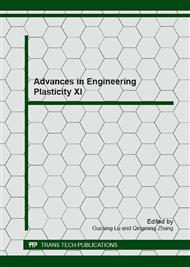p.292
p.296
p.300
p.306
p.310
p.314
p.318
p.322
p.326
Metallic Bipolar Plate Fabrication Process of Fuel Cell by Rubber Pad Forming and its Performance Evaluation
Abstract:
Recently, the demand for energy is growing at a very high rate all over the world. The fossil fuels eventually lead to the foreseeable depletion of limited fossil energy resources. Hydrogen is considered a promising candidate to remedy the depletion of fossil fuels. The bipolar plate is the second most important component of a proton exchange membrance (PEM) fuel cell stack after the membrance electrode assembly (MEA). Its primary roles are to supply reactant gases to the fuel cell electrodes and provide electrical connection between adjacent cells in the stack while removing product water from the cell and transferring away the heat of reaction. Historically, machined graphite had been chosen as a good compromise between all of these requirements, but alternatives are emerging. New materials are light metals. In this study, rubber pad forming process was employed as the manufacturing method for metallic bipolar plates. The rubber pad and the sheet metal plate were pressed together by the punch, and the repulsive force of the deformed rubber is loaded at the plate, and can contribute to improving formability. And then, its surface was coated with TiN. After coating process, the performance characteristics of single stack in the condition of PEMFC using the metal bipolar plate have been investigated.
Info:
Periodical:
Pages:
310-313
Citation:
Online since:
January 2013
Authors:
Keywords:
Price:
Сopyright:
© 2013 Trans Tech Publications Ltd. All Rights Reserved
Share:
Citation:


